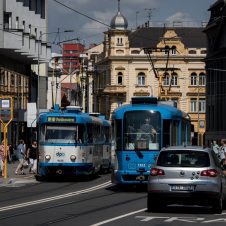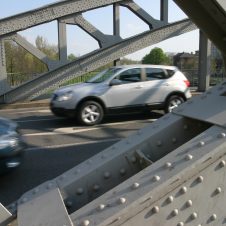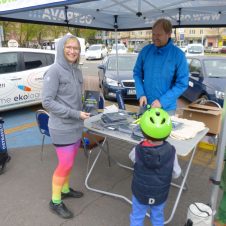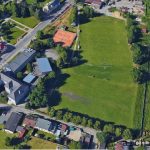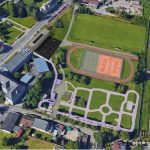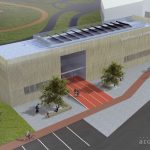Thematic articles
Projects
-
‘Bike to Work’ competition now open
-
Kaipan electromobile
-
StudentCar SCX
-
Plans for a new road safety centre
-
Bohumínská Street is being re-routed underground
-
Transport guard viaRODOS
-
Bikesharing
-
Cable car route
‘Bike to Work’ competition now open

This year the City of Ostrava is cooperating with the Auto*Mat association, the organizer of the ‘Bike to Work’ competition. This annual nationwide event promotes cycling as an everyday form of commuting to work, and this May it is being held for the eighth time.
According to the competition’s organizing team, the aim of the event is to motivate as many people as possible to use cycling – or other non-motorized forms of transport, including walking or running – when commuting to work. If people stop using cars every day, they will soon feel a number of benefits. They will improve their physical fitness (and their mood), and they will also contribute to improvements in air quality – all helping to make the city a safer, more pleasant place to live and work. The motto for this year’s competition is ‘Save the City’.
The competition is a team event. Colleagues form teams of between 2 and 5 members, and each team must regularly cycle to work together during May. This year, as in the previous two years, the competition is also open to people who commute in other ways – walking, running, skating, skateboarding, wheelchair users, and more…
The competition includes several categories evaluating entrants based on how regularly they cycle (walk, run etc.) to work, the length of their journey, creative ideas, and more. Employers can also compete for the title ‘Cycle Employer of the Year’ or ‘Best Competition within a Company’. One of the aims of the event is to persuade employers to create proper facilities for employees who cycle to work (bike stands, showers, changing rooms, and so on).
There is a small fee for participating (either 290 CZK or 390 CZK depending on the registration date). The fee includes the price of a T-shirt with the competition logo; the wearer can get discounts at a range of events run by the local coordinator.
Ostrava is this year’s local coordinator
This is the first year in which the City of Ostrava is directly involved in the ‘Bike to Work’ competition as the local coordinator, though in previous years up to 500 local citizens participated in the event. So help us to increase this number! Join our local ‘Bike to Work’ Facebook group (‘Do práce na kole – Ostrava’) and tell us:
- What prizes do you want to compete for?
- What “T-shirt events” you would like to see?
- Would you like to take part in a cycle ride in May?

- Place
- VŠB - Technical University of Ostrava
- Website
- http://www.zlepsisitechniku.cz/kategorie/technicke-vychytavky/
Kaipan electromobile

The first car to exceed the speed of 100 km/h was an electric vehicle. The first car to run on the moon was also an electric vehicle. And someday, when the oil runs out here on Earth, electric vehicles will probably be the primary means of transportation. And who knows whether that won’t occur soon due to current technological progress, as we have been working on electric-drive technology also in the Czech Republic for a number of years.
The first model, called the K0, saw the light of day at the end of 2009 and travelled 107 km on one charge at the track in Nošovice. Its drive system is intended for suburban operation and the vehicle achieved a maximum speed of 65 km/h, with battery life of more than 300,000 km. Later prototypes exceeded the speed of 100 km/h with no trouble and successfully approached the range threshold of 200 km on one charge, which is more than most of us need when commuting for work or pleasure.
However, the university team still was not satisfied. The idea of having solar panels on the roof of a house and, in the garage, an electric vehicle charged by those panels is more than inspiring. And if the car isn’t at home, energy is stored in batteries or hydrogen and can then be used to simply “fill up” the car. No filling stations, no more spending money on petrol. That’s a great idea, isn’t it? And its realisation is not far away. The latest prototype, the K3, is now taking shape. The K3 is an experimental vehicle for testing hybrid sources of energy, such as batteries, hydrogen fuel cells and electrical central units powered by petrol and CNG/LPG. This functions is such a manner that of this sources is installed in the vehicle with a supercapacitor and propulsion is provided by an electric motor.
It seems complicated, doesn’t it? Perhaps at first glance, but our goal is simple: to build a drive system that will take a car as quickly and as far as possible on one charge and as cheaply and ecologically as possible without depending on fossil fuels.
Faculty of Electrical Engineering and Computer Science, VŠB – Technical University of Ostrava, in cooperation with Kaipan, s.r.o. and Isotra, a.s.
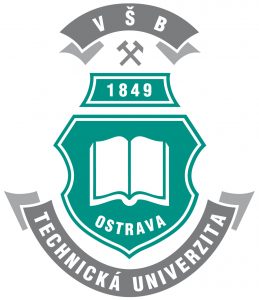
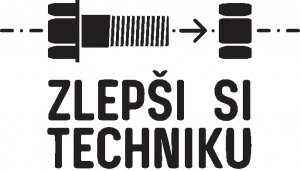

- Place
- VŠB - Technical University of Ostrava
- Website
- http://www.zlepsisitechniku.cz/technicke-vychytavky/klukovska-hracka-na-dalkove-ovladani/
StudentCar SCX

We often hear that electric cars are the vehicles of the future. But the subject of debate are also arguments that the production of electric vehicles is very expensive, that it is uncompetitive so far, and it is subject to great pressure of automobile and oil companies. However, the world oil reserves are steadily disappearing and electric cars can be an adequate substitute of present-day vehicles operating on petrol, diesel or gas. Therefore, it is necessary to deal with the development of electric cars on the grounds of technical universities as well.
In 2011, the Department of Vehicle Materials and Technologies developed the electric car StudentCar SCX. The result of teamwork for students and engineers is a low two-seater coupe with sophisticated timeless lines. StudentCar SCX is the first sports electric car developed and manufactured in the Czech Republic, whose performance is comparable with the current world leaders. It is a harmonious combination of design and technology friendly to the environment while achieving outstanding driving characteristics and excellent driving dynamics.
SCX has a unique arrangement of the electric 4×4 drive, which consists of four synchronous motors controlled by four frequency converters. It achieves acceleration of 4.9 seconds from 0 to 100 km/h and 9.2 seconds from 0 to 150 km/h, it goes round bends without problems at high speeds with lateral overload of more than 1 G.
The interior of the vehicle is equipped with modern technology for displaying dashboard data in the form of a pair of displays and 10″detachable tablet. The interior upholstery is made with great care and perfect workmanship. A major task for the team collaborating on the development of SCX was the approval of the operation on roads, which was also successful.
When it whizzes by, you might say to yourself it is time to replace your “Diesel” or “Petrol” for something greener.
The team led by Petr Tomčík from the Faculty of Metallurgy and Materials Engineering, VŠB-TUO worked on the project, the development was funded by TA01030430, TA ČR (Technology Agency of the Czech Republic) “Applied research and development towards increasing the safety of vehicles with electric drive – electric vehicles and reducing their negative impacts on the environment”.
fmmi.vsb.cz


Plans for a new road safety centre

The City of Ostrava has recently unveiled plans to build a new road safety centre in the Svinov district (at the primary school in Bílovecká St.). The new centre – which was jointly presented to the public by Councillor Lukáš Semerák and the Mayor of Svinov Helena Wieluchová – will include a state-of-the-art traffic simulation area with electric buggies (so children will be able to learn about safety not only as pedestrians or cyclists, but also from the perspective of drivers). There will also be an athletics track, a football pitch, a tennis court, a three-storey building with a teaching room for 30 children, changing rooms, a club room, storage facilities and a garage area.
- Visualization
- Visualization
- Visualization
The new centre will cover an area of 3.5 hectares. Construction work will begin next year, and completion is scheduled for 2019. During school hours the centre will be used by school groups; during afternoons and at weekends it will be open to the general public. The total cost of construction is estimated at approximately 50 million CZK. Around 20 million CZK will be required for the traffic simulation area and the outdoor sports facilities, while the building itself will cost around 30 million CZK.
City Councillor Lukáš Semerák – whose main area of responsibility is transport – explained why the new centre is necessary and why the City has decided to fund it:
Ostrava currently lacks sufficient facilities for compulsory primary school courses in road safety. The new centre will be located in Svinov – but it will also serve the neighbouring district of Poruba and other municipal districts.
The Svinov complex will be Ostrava’s third road safety centre. The Ostrava-Jih municipal district (in the south of the city) uses the traffic simulation area at the Alberta Kučery primary school, where the outdoor surfaces were repaired by the City last year. The districts of Moravská Ostrava, Slezská Ostrava and Mariánské Hory use the facility at Orebitská St. in Přívoz, which will be renovated and extended during next year.
The new Svinov facility will be the most modern of its type in Ostrava; it will be the only road safety centre to have electric buggies, traffic lights, speed measurement and other simulations of authentic road traffic situations. Children will also enjoy the opportunity to participate in road safety teaching in the role of vehicle drivers.
Bohumínská Street is being re-routed underground

Ostrava’s Mayor Tomáš Macura has recently unveiled the City’s bold new plans to re-route Bohumínská Street – a busy four-lane highway running through the central part of the city – into a tunnel. At surface level there will be a standard two-lane street, with lower speed limits, traffic calming measures and plenty of pedestrian crossings; the project will help to revitalize the embankment area of Slezská Ostrava and make it a fully-fledged part of the city centre once more.
Bohumínská Street is a busy transit route, and re-routing heavy goods vehicles and other through-traffic underground will radically transform this part of the city. The project will reconstruct a kilometre-long stretch of the street between the junctions with Dědičná St. and Těšínská St. A feasibility study showed that the project is fully viable, so the City announced a public tender for preliminary investment plans; the winning proposal was submitted by Prague-based company Samson. The full investment plan (at a cost to the City of 930 000 CZK) will be completed by the middle of 2018; an integral part of the plan will be the design of the surface-level layout and features that will help to revitalize the area.
Tomáš Macura explained the City’s plans:
Bohumínská Street is currently a major barrier to movement, and it has essentially destroyed the historic centre of Slezská Ostrava. By re-routing goods vehicles and some private cars underground, we will greatly reduce traffic intensity at surface level – and we will also be able to create an attractive environment where people will enjoy spending time. That means expanding and revitalizing public spaces (such as Gagarin Square), and it will also act as a springboard for future development projects on the right bank of the Ostravice River.
Because this is a very sizeable investment, the implementation of the plans will not begin until after 2020. The precise costs have not yet been calculated, but a rough estimate puts the total investment at around 2 billion CZK. The City expects to be able to part-finance the investment using national and European funding.
Mayor Macura also outlined the City’s plans for another similar location, Místecká Street (on the opposite side of the city centre):
Here too, the four-lane highway represents a major barrier to movement in the very heart of Ostrava, and we would also like to re-route it into a tunnel. However, these plans are not yet detailed and specific enough for us to be able to announce a tender for potential investors.
Transport guard viaRODOS

None of us drivers likes when the traffic is tailing back and there are traffic jams on the roads. But if it occurs, we would like to learn most accurate information about where they are, how long we will be delayed, and possibly which way they can be effectively bypassed. In today’s technical world, it should not be much of a problem – we have satellite radios and smart phones with the Internet access. But few realize that there are people behind this whole technology, delivery of information, and system development.
Along with the developed supercomputer, we can solve problems about which could only dream while we were using ordinary computers. Among other things, we deal with modelling, management and optimization of transport. We developed the system viaRODOS, which informs drivers of the current traffic online. We receive entry information from 130,000 reference vehicles whose movement is monitored by satellite systems. Satellite units, which give information about the position and velocity every single minute, are places along five percent of all roads in the Czech Republic. Based on the tests and the references, it is now clear that this is one of the most accurate traffic monitoring systems in Europe.
Another significant help for the movement of drivers is monitoring cities – Prague, Brno and Ostrava. On an interactive map, drivers can display the current traffic situation in individual streets, every train of vehicles and the length of waiting with minute precision.
Our application is still improving. Not only do we monitor traffic on roads in cities and outside them, but we are developing a system to predict the traffic situation in the country. We continuously analyse huge volumes of historical data and compare them with the current measured situation. The resulting model allows us to predict when and where the traffic will start tailing back on the road, how long the delay will be, and it will enable us to propose currently the best route for each user in terms of time and transportation costs.
The Transport Systems Development Centre (RODOS), which operates under the National Supercomputing Centre IT4Innovations of VŠB-TUO
Bikesharing

From 2018, citizens and visitors will be able to use a new bikesharing system. The City is keen to increase the number of active cyclists, improve the modal split in favour of cycle journeys, and support eco-friendly urban transport in general. The bikesharing scheme will cover the city centre and surrounding districts, contributing to the revitalization of these areas. To motivate people to use the scheme, bikes will be available free of charge for a set length of time. A dense network of bikesharing points will cover key transport hubs, large office complexes and public buildings, linking them with the city centre and other tourist destinations. The scheme may subsequently be expanded into other parts of Ostrava.
Ostrava’s bikesharing scheme – which forms part of the City’s Strategic Development Plan – has been launched after many months of detailed preparation. From 1 May, bike stations has been located at 39 different locations in the wider city centre. During the opening phase of the project, a total of 180 bikes is available for public use; these urban bikes will feature low saddles for easy mounting and dismounting, coaster brakes (where you pedal backwards to apply the brake), and a practical front basket for carrying small loads. The service is provided by Rekola Bikesharing, and it will not cost the City anything. The bikesharing scheme runs from May until the winter season (at the latest 21 December, when the contract with Rekola expires).
The scheme enables users to borrow a bike at one station and return it at a different location. Each station includes a mobile stand with space for 6–12 bikes. It is only possible to return a bike to one of the stands listed in the system (in the app or on the web). If a user fails to return the bike to one of the stands, a fine will be charged. The bikes are regularly collected and taken to other stations within the city, which ensures that all stations are kept properly stocked at all times.
At the end of this year, the City of Ostrava and Rekola will evaluate the level of public interest in the scheme (both among citizens and visitors to Ostrava) during the first phase of the project. Depending on the results of the evaluation, the service may be adjusted and/or expanded to serve other parts of the city.
The first 15 minutes are free of charge, and there is a charge of 18 CZK for the next 45 minutes. After that first hour, each 15 minutes costs just 6 CZK. Before borrowing a bike, users need to register in the Rekola system. It is also possible to use SMS text messages for borrowing and returning bikes; each message sent costs the user 1 CZK, and users are billed at the start of each month. Rekola provides user info via a telephone call centre (in Czech and English) on weekdays from 9:00–17:00, as well as via e-mail, Facebook messenger, the company’s website, and smartphone apps (iPhone, Android).
The origins of the bikesharing scheme
The origins of the bikesharing scheme date back to 2016, when the City carried out a survey to determine the level of public interest in such a project. Almost 1700 people replied, and almost 90% of respondents supported the idea: 63% said they would use the scheme occasionally, and 24% said they would use it on a regular basis. The questionnaire also revealed that most of Ostrava’s citizens travel either by car or by public transport; only 7% are cyclists. It is expected that the bikesharing scheme will help increase this figure.
Respondents to the City’s questionnaire identified a number of key locations where they considered bikesharing to be particularly useful. These included the main square in the city centre (Masarykovo náměstí), Lower Vítkovice, the Forum Nová Karolina shopping mall, and the main railway station.
The precise locations of the bikesharing stations can be viewed on a map here: https://mapy.cz/s/2wDXV. Other information also at http://fajnova.cz/projekt/bikesharing-ostrava/.
Ostrava has supported cycling in the city for many years. There are around 250 kilometres of dedicated cycle routes within the city, and more are currently being built or planned. The introduction of the bikesharing scheme represents a further step towards creating a healthier, cleaner and more eco-friendly transport system in Ostrava.
Cable car route

Ostrava plans to build a cable car route linking the city centre with the most visited tourist destinations (Lower Vítkovice and Landek Park – up to 1.3 million visitors per year). A feasibility study has shown that the project is viable and can proceed to the next stage. In view of the cost, the cable car will not be part of the public transport network, but it will be linked to it. The journey between the Lower Vítkovice industrial heritage site (the fourth most visited tourist destination in the country) and the zoo will take just 11½ minutes. The City is currently seeking an investor for PPP (public-private partnership) funding. The cable car will help to reduce car traffic in the city centre.
Fact sheets
City public transport

The number of passenger journeys using Ostrava’s public transport system in 2016.
City public transport

After 10 years of slow decline, public transport passenger numbers are rising again.
City public transport
City public transport
![]()
Low-emissions buses as a percentage of all buses in Ostrava. These buses meet EURO5/EURO6 standards or use CNG.
City public transport
![]()
Introduction of a system enabling passengers to pay using contactless bank cards in all Ostrava city public transport vehicles. The system has helped to generate an increase in passenger numbers.
City public transport

Ostrava’s electronic public transport ticket sales system is the second in the world (behind only London) in terms of its modern conception and passenger convenience.
Transport terminals

As part of the programme to create a fully integrated public transport system, the City of Ostrava has built 4 key transport terminals (Svinov, Main Railway Station, Hranečník, Dubina).
Cycle transport

The total length of all cycle routes, lanes and paths in Ostrava (1 December 2016).
Cycle transport

The target length of Ostrava’s cycle routes – set out in the Concept for the Development of Cycle Transport in Ostrava.




